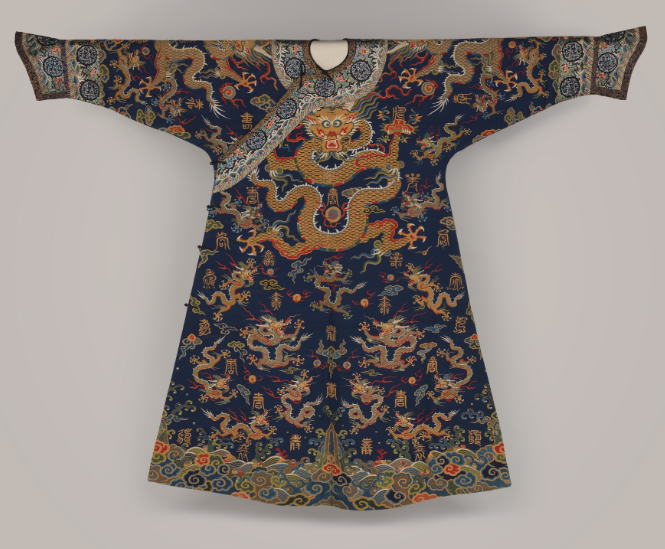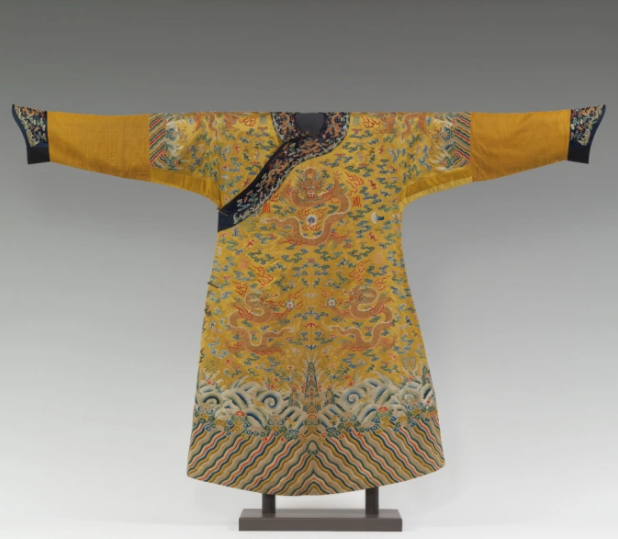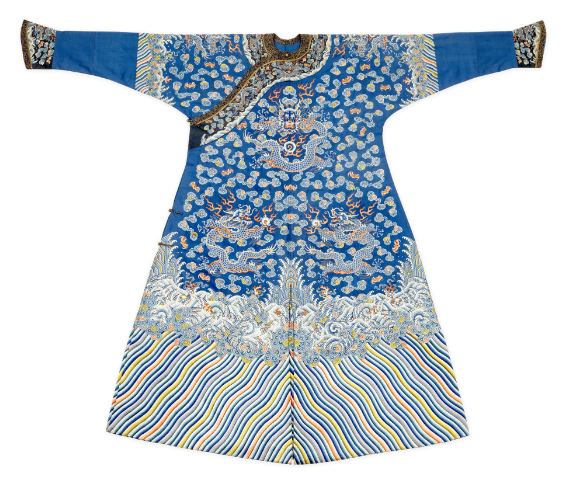Overview of Qing Dynasty Dress Codes
The Qing Dynasty, ruling from 1644 to 1912, showcased a distinct fashion era in Chinese history. Clothing not only served a practical purpose but also acted as a symbol of status, ethnicity, and political allegiance.
Historical Background
The Manchu rulers of the Qing Dynasty introduced unique dress codes, reflecting a blend of Manchu and Han Chinese styles. This era saw the strict enforcement of specific attire for officials, denoting their rank and position. The Dragon Robe, known as the “longpao”, stood out as a symbol of imperial authority.

Influence of Confucianism and Rituals
Confucian ideals deeply influenced the dress codes, emphasizing modesty and hierarchy. Clothing during this period adhered to Confucian norms, where different garments were designated for various ceremonies and seasons. The use of color, material, and design followed a rigid protocol, reflecting the wearer’s social status and occasion. For example, the Emperor’s ceremonial robes, rich in symbolism and adorned with dragon motifs, were exclusive to him, embodying the mandate of heaven.
Throughout this period, the Qing Dynasty dress codes, detailed in their implementation, mirrored the complex societal structures and cultural practices of the time. The intricate designs and quality of the garments from this era, now preserved in museums, continue to inspire modern fashion designers. For more detailed information on the specifics of these dress codes, you can refer to the Wikipedia page on Qing Dynasty clothing.
The Four Categories of Imperial Robes
In the Qing Dynasty, imperial robes fell into four main categories, each serving distinct purposes and showcasing exquisite craftsmanship. These categories included ceremonial robes, official court attire, military uniforms, and casual wear.
Description of Each Category
- Ceremonial Robes: Reserved for grand occasions, these robes featured intricate embroidery, often with dragon motifs symbolizing imperial power. The Emperor’s robe, adorned with nine dragons, represented the highest level of authority.
- Official Court Attire: This category included robes worn by officials during court assemblies. They displayed rank badges, identifying the wearer’s position and status within the court hierarchy.
- Military Uniforms: Designed for practicality, these uniforms were less ornate but embodied strength and valor. They often had broader sleeves and sturdier fabrics to accommodate physical activities.
- Casual Wear: Used in everyday life, these robes were simpler and more comfortable, yet still elegant. They reflected the personal taste of the wearer and varied greatly in color and fabric.
Symbolism and Significance
The imperial robes of the Qing Dynasty were more than mere clothing; they were symbols of power, culture, and tradition. The choice of color, fabric, and design in each category held deep cultural significance. For instance, yellow, reserved for the Emperor, signified centrality and supreme power. The use of specific symbols like dragons or phoenixes denoted authority and imperial favor.
Each robe, meticulously crafted, represented the culmination of traditional Chinese artistry, encapsulating the social, cultural, and political ethos of the Qing Dynasty. For a deeper understanding of the symbolism in Qing Dynasty clothing, the Wikipedia page on Chinese dragon symbolism offers additional insights.
Materials and Craftsmanship
The Qing Dynasty marked a pinnacle in Chinese textile artistry, with imperial robes crafted from the finest materials and displaying exceptional craftsmanship. These garments were a testament to the skill and precision of the artisans.
Types of Fabrics Used
- Silk: The most prevalent material, silk, symbolized luxury and status. Its varieties, such as satin and damask, were highly valued for their sheen and durability.
- Fur: Used for warmth and opulence, fur from animals like foxes and sables adorned winter garments, especially for the higher echelons of society.
Artistry in Embroidery and Design
Embroidery on imperial robes was an art form in itself, often depicting traditional motifs such as dragons, phoenixes, and auspicious symbols. Artisans used a range of stitches, some so fine that they were almost invisible, to create detailed and vivid designs. The color palette was equally significant, with each hue chosen for its symbolic meaning.
The combination of luxurious fabrics and intricate designs made these garments more than just clothing; they were masterpieces of cultural expression. The labor-intensive process and attention to detail in each robe spoke volumes about the artisans’ dedication and the importance of these garments in Qing society. To explore more about traditional Chinese silk, the Wikipedia page on Chinese silk provides further insights.
Color Significance in Imperial Attire
In Qing Dynasty imperial attire, color was not just an aesthetic choice; it was steeped in symbolism and tradition. Each color had specific meanings and was chosen with great care to reflect status, occasion, and even philosophical beliefs.
Meaning of Specific Colors
- Yellow: Reserved exclusively for the Emperor, yellow symbolized the center of the universe and ultimate power. It was often associated with the Earth element in Chinese cosmology.
- Blue and Green: Representing spring and growth, these colors were common in robes worn for ceremonies related to agriculture.
- Red: Symbolizing good fortune and joy, red was often used in wedding attire and festive occasions.
- Black and White: Generally used in mourning attire, these colors signified respect for the deceased and the solemnity of death rituals.

Variations Across Different Robes
The use of color in imperial robes varied based on the specific function of the garment. For instance, ceremonial robes worn for specific rituals might feature auspicious colors like red or purple, while everyday robes would often be in more subdued tones. The Emperor’s hunting attire, designed for outdoor activities, would usually incorporate darker, earthier colors for practicality.
This intricate color coding in Qing Dynasty clothing was not only a reflection of societal norms but also an expression of cultural values and beliefs. For a comprehensive understanding of traditional Chinese color symbolism, the Wikipedia page on Color in Chinese culture offers extensive information.
Robes for Different Occasions
In the Qing Dynasty, robes varied greatly depending on the occasion, reflecting the importance and nature of each event. This variety showcased the dynasty’s rich cultural tapestry and strict adherence to protocol.
Court Ceremonies and Rituals
During grand court ceremonies and state rituals, officials and the Emperor wore elaborately designed robes. These garments, often adorned with intricate embroidery and symbols of power like dragons, signified their high status and the solemnity of the occasion. The Emperor’s robe, for instance, often featured nine dragons, symbolizing supreme authority.
Daily Wear and Seasonal Changes
For everyday wear, the clothing was more practical and less ornate. These robes were lighter, made of comfortable fabrics suitable for daily activities. Seasonal changes also influenced the choice of attire; lighter silk garments were preferred in summer, while heavier, fur-lined robes were worn in winter for warmth.
The diversity in robes for different occasions in the Qing Dynasty reflects the intricate social hierarchy and the cultural importance of clothing in expressing identity and status. For more information on the traditional clothing of different Chinese dynasties, including the Qing, the Wikipedia page on Chinese clothing is a valuable resource.
Evolution and Legacy
The Qing Dynasty’s imperial robes underwent significant evolution over time, reflecting changes in political, social, and cultural dynamics. This evolution has left a lasting legacy on modern fashion, blending traditional aesthetics with contemporary designs.

Changes Over Time
Initially, Qing robes showcased strong Manchu influences, characterized by straight cuts and practical designs suitable for horseback riding. Over time, as the Manchu rulers assimilated more with Han Chinese culture, the robes became more ornate and elaborate, integrating Han elements like intricate silk embroidery. The fall of the Qing Dynasty led to a decline in traditional attire, giving way to more Westernized clothing styles.
Influence on Modern Fashion
Today, the legacy of Qing imperial robes continues to inspire modern fashion designers. Elements such as silk brocade, fine embroidery, and symbolic motifs from these robes are often incorporated into contemporary haute couture. Fashion shows around the world sometimes feature collections that reinterpret these traditional designs, showcasing their timeless beauty and cultural significance.
The enduring influence of Qing Dynasty attire demonstrates the deep historical roots and ongoing relevance of traditional Chinese fashion elements. For insights into how traditional Chinese clothing has influenced modern fashion, the Wikipedia page on Fashion design provides useful context and examples.